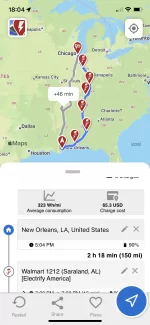Glad I stumbled into this thread. This has been on my mind lately, as I wait for any update on my Pure reservation. I've been told Q3 (yeah, right - I am planning on Q1 of 2023).
Here is my scenario: I am a snowbird, with a winter home in Fort Myers, Florida, and a condo just outside of Boston, MA. Every six months or so, I drive my Toyota Tacoma (20 MPG - 420 mile range) or Toyota Avalon (25 MPG - 450 mile range) from one destination to the other. That's approximately 1600 miles, over 3 travel days. I typically drive ~500 mile stretches every day, which means that I stop for 15 minutes to fill the tank once during the drive at between 380 and 400 miles, and then top the tank off at the end of the day.
[EDIT] Also; I will NEVER again drive over the GW Bridge - NEVER! I also STRONGLY prefer to go the inland route for most of the trip north: 95N to 26N toward Columbia SC, to 77N to Dublin, VA to 81N through Harrisburg, PA to 78N to 287, across the Tappan Zee (or whomever it has been renamed to) to 95N.[/EDIT]
How should I plan this out with a Lucid Air Pure? Do I plan to stop after 324 miles (80% of 406 miles), and then top off at the end of the day? Should the planned stop be sooner, later? What about preconditioning the battery? Do I do this before every charging stop of the trip? Will pre-conditioning affect the range during the trip? Will making this trip affect the overall life of the battery pack?
I wish that Lucid would offer Battery As A Service, as NIO and Gogoro do with their cars and scooters in China. The idea of pulling into a station, and having a newer freshly charged battery swapped into my vehicle in about 5 minutes is VERY appealing to me.

